Log in or create new account to save this product to your wishlist.
How to get rid of clover in your lawn – tackling your clover crisis once and for all!
Address your clover crisis the natural way!
Latest articles
7 MIN 22 Jul How to keep your lawn in shape this summer 9 MIN 15 Jul Watering Your Garden: 10 Top Tips! 11 MIN 15 Jul Is Your Grass Type Right for your Garden? 11 MIN 10 Sep Create Your Low-Maintenance Garden – Tips and Ideas 11 MIN 08 Sep The Ultimate Guide to Choosing the Perfect Hedges for Your Garden 12 MIN 30 Aug The Top 20 Evergreen Climbers to Transform Your GardenAre you forever looking out for that inimitable four-leaf clover? If you are, you’re probably an optimist — good on you. However, clover shouldn’t overtake a healthy lawn — its presence isn’t lucky; it’s a sign of nutrient deficiency and poor soil.
- What IS clover, exactly?
- The benefits of clover in your lawn
- What is the presence of clover telling me about my lawn?
- How to recognise the type of clover in your lawn
- Which varieties of clover are most commonly found in the UK?
- What damage does clover do to my lawn?
- How to get rid of clover in your lawn – 5 methods
- How to prevent clover in your lawn
Sorry to break the myth! Keep up the optimism, though!
This article explains how to get rid of clover in your lawn. We’ll explore the natural ways to eradicate the problem while investigating a couple of more nuclear approaches to removing this common weed from your grass.
Ready? Let’s get started.
What IS clover, exactly?
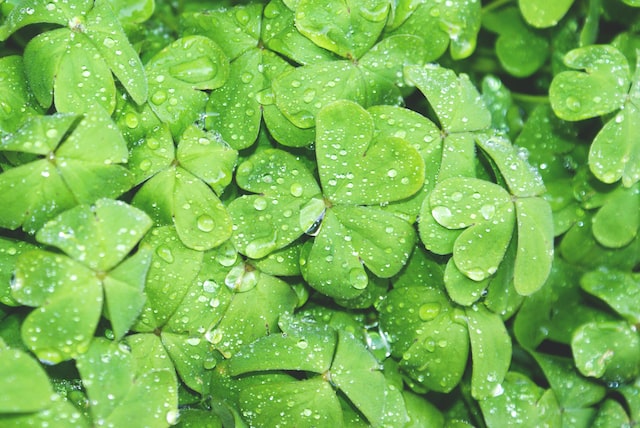
First up, the big question: is clover a weed?
Truthfully, a plant and a weed are kind of the same thing. What differentiates a plant from a weed is that we’ve physically planted it and want it. Unwanted plants in our garden are considered weeds, so clover is often bundled up in the “weed” category.
But:
Clover is a perennial wildflower, and it’s particularly challenging to remove once established. However, the desire to remove clover from a lawn is quite a modern phenomenon — it used to be considered an essential element of a lawn.
The benefits of clover in your lawn
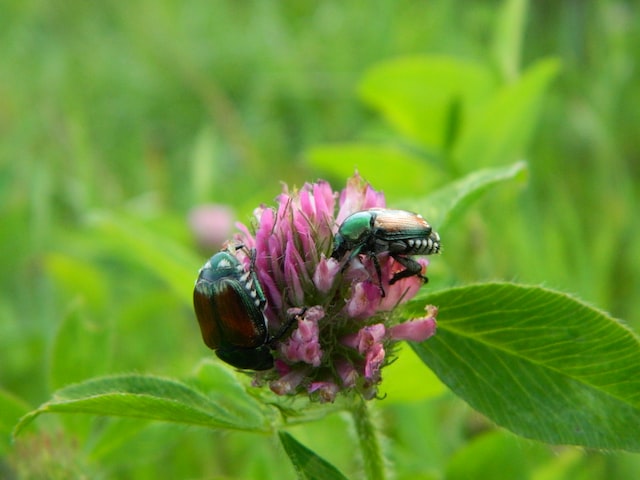
It might seem like an odd subheading in an article about eradicating clover but stick with me here.
- Clover is drought tolerant, needs less water than grass, and stays green longer than your typical grass plant. Clover keeps your garden looking green during periods of drought.
- Clover harvests nitrogen from the air and releases it into the soil. You’ll find a high proportion of clover in green manure, which break down compacted soil and boosts the nitrogen content of the earth.
- Lawns consisting entirely of clover require hardly any mowing.
- Clover grows in most soils and attracts pollinators to your garden.
- The root system of clover plants is persistent and aggressive, choking out most other weeds.
- Clover is an excellent deterrent to lawn pests.
- Clover is edible. However, you should avoid eating too much, as it causes bloating in large amounts.
- Clover is a potent source of nectar for insects.
Nonetheless, we’re all about picture-perfect lawns here at MOOWY. And the presence of clover can indicate problems with your garden soil that are weakening your grass plants.
And for this reason, clover is often referred to as a “pointer plant”.
What is the presence of clover telling me about my lawn?
Clover indicates a problem with your soil. And overcoming that problem will help strengthen your grass plants for a more beautiful, resistant lawn.
Clover tells you that:
- Your soil is unbalanced — lawns require a neutral pH level, and the presence of weeds often indicates that the earth is too acidic. Add Lawn Lime to address soil acidity and kill moss simultaneously.
- Your soil is undernourished — if you don’t regularly fertilise your lawn soil, it becomes depleted. Poor soil is bad for your lawn but brilliant for weeds like clover.
- You mow your grass too short — the shorter your grass, the more sunlight reaches the soil surface, and this is where clover thrives. Longer grass keeps the soil surface in greater shade, making the surface less hospitable to clover.
- Your grass is thin — just like cutting your grass too short, thin grass provides plenty of space for weeds. Solve a thin lawn by overseeding every year.
How to recognise the type of clover in your lawn
There are over two hundred varieties of clover, with a handful commonly found in the UK. The most recognisable characteristic is the trifoliate leaves — that means there are three opposing leaves per stem; although, records confirm that in rare cases, clover has been found with up to 56 leaves growing from one stem!
The leaves
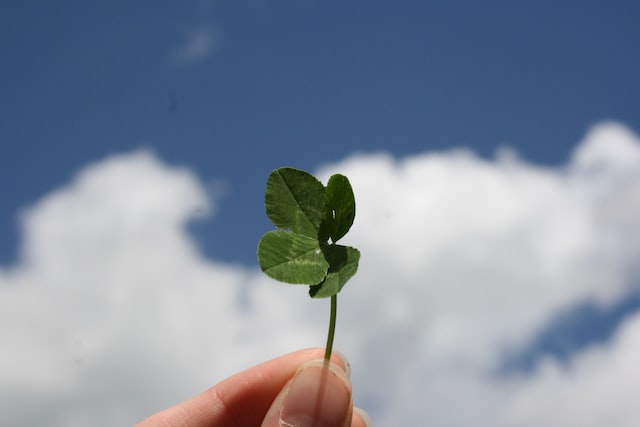
The leaves are most commonly found in bunches of three — green in colour and oval-shaped. Many clover varieties have a characteristic point at the tip of the leaf, resembling the “club” found in a pack of cards.
You’ll often find a light line across the leaf, resembling an eyebrow.
Flowers
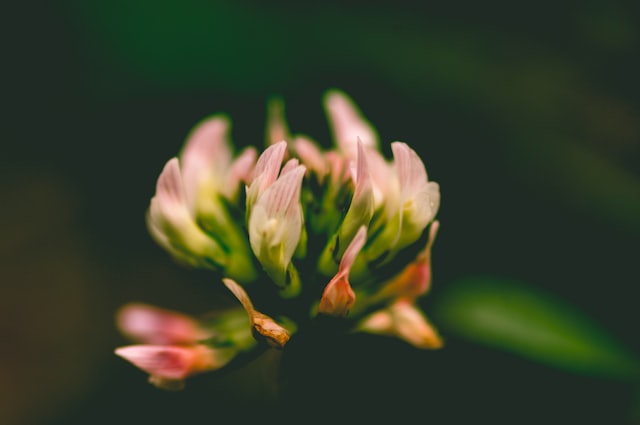
The clover plant is classed as a legume, which is a member of the pea family — producing seed pods. Please note that not all legumes are edible, so practice caution if you’re going to eat them.
Clover produces tubular flowers that grow in “balls”. The petals can be a variety of colours; most commonly white or pink, but also found in red, purple, or yellow.
Which varieties of clover are most commonly found in the UK?
Red clover
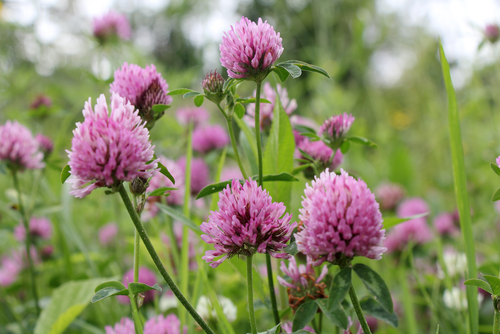
With pretty pink and red flowers, red clover blooms from May to October. Like most clovers, it’s a perennial — it’s difficult to remove once established.
Red clover has a range of historical medicinal uses, treating a range of conditions, including:
- Cancer prevention
- High cholesterol
- Indigestion
- Cough
- Asthma
- Bronchitis
- STDs
White clover

This creeping plant spreads across your lawn rapidly and — left to its own devices — can take over your lawn completely.
Again, it flowers from May to October and is the most likely variety to produce those lucky four-leaf clovers.
Jumping clover
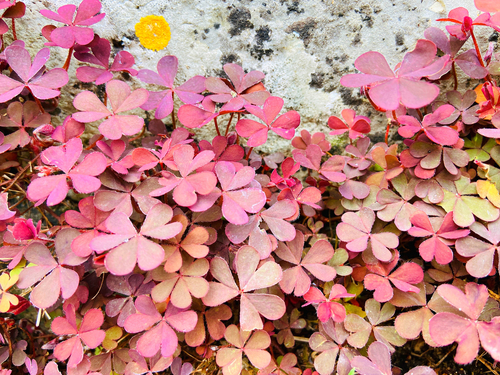
Don’t worry — this isn’t going to leap for your throat like a rat. Little seeds pop out if you touch the leaves, giving the plant its rapid spread.
The leaves are reddish-brown, and the little flowers are bright yellow, like a buttercup. These plants often grow in the gaps between your patio tiles.
Jumping clover is known by various names, including Spring Clover and Horned Wood Sorrel.
What damage does clover do to my lawn?
As I’ve explained, clover isn’t particularly damaging, per se, but it can overtake your lawn if left to nature. In fact, clover naturally fertilises your grass because it draws nitrogen into the soil, which helps boost the green colour of your lawn.
And clover takes up the space that other, more damaging, weeds might take root.
However, getting rid of clover in your lawn is an aesthetic choice. And ultimately, the best way to avoid clover is to ensure that your grass plants are as healthy as possible.
How to get rid of clover in your lawn – 5 methods
There are many ways to get rid of clover in your lawn. These are the most common approaches:
1. Remove it by hand
Because clover is a stubborn perennial, one of the most effective ways of eradicating it is to dig it out of the ground. But, like all weeds, the roots are pretty deep, so you must remove the entire root system for the best results.
- Dig the clover with a spade, ensuring that you remove the entire root system. You may need to dig 3-4 inches deep.
- Refill the hole with fresh soil, and press down lightly.
- Sow high-quality grass seed over the bare soil.
- Spread a little fertiliser over the seeds (check the packet, as some fertilisers interrupt germination).
- Keep the area moist, and avoid walking over it for two weeks until the seeds have sprouted.
2. Fertilise your lawn to remove clover
Provide the correct nutrition for your lawn, and it will thrive — preventing the space for clover and weeds from taking root.
I recommend fertilising your lawn three-to-four times a year — that way, it will develop density and vitality. This means that clover has nowhere to go.
Fertilise in the spring, early summer, late summer, and autumn.
3. Mow your lawn regularly (but not too short)
Mowing your lawn triggers a growth hormone in the plant, which makes it stronger, denser, and more resistant to disease. When you mow, you provide space for oxygen and sunlight to reach the soil, and this helps your grass plants grow deeper roots (and deeper roots make your plants more drought resistant).
However, mowing too short can encourage clover — avoid cutting shorter than 4-5cm.
Check out our expert’s guide to mowing your lawn.
4. Attack clover with vinegar
You can use a broad-leaf weed killer to eradicate your clover. Still, I wouldn’t recommend using harsh chemicals in your garden because they can damage wildlife and unsettle your garden’s delicate ecosystem.
However, you could try using a vinegar solution and washing up liquid for a non-toxic weed killer.
- Mix one part vinegar with one part water.
- Add a drop of washing-up liquid.
- Put the mix into a spray bottle, and shake well.
- Spray the mix onto your clover. The washing-up liquid helps the mix stick to the plant, and the vinegar will dry out the leaves.
- Continue to spray for several weeks until the clover has entirely died.
However, avoid spraying vinegar onto your grass because it can scorch the leaves.
5. Remove clover by scarifying
While scarifying is quite a nuclear way of eradicating clover from your lawn, it’s highly beneficial for your grass plants.
Scarifying is the process of “scratching away” the top layer of turf, removing weeds and moss in the process. Although your lawn will appear utterly decimated, it will bounce back more robust and vibrant in a couple of weeks.
- Ideally, apply fertiliser around 3-4 weeks before scarifying.
- Rake away leaves, stones, and branches from the lawn surface.
- Mow short, and then scarify once horizontally, then again vertically.
- Overseed with fast-growing lawn seed and water well for the next two weeks.
Check out our expert’s guide to scarifying your lawn.
How to prevent clover in your lawn

Maintaining the health of your lawn is the best defence against clover and other weeds. So:
- Keep your soil in check — perform a soil acidity test once a year, and apply Lawn Lime to neutralise the pH level. Add iron sulphate annually to help your grass plants absorb available nutrients for grass that’s so healthy it literally glows.
- Overseed annually with high-quality seed — a young lawn is a healthy lawn, so spread lawn seed over your existing lawn each year. The density of your lawn will improve, as will its resistance to drought, disease, and weeds. Find out more about overseeding.
- Keep your lawn watered — clover is more drought-resistant than grass, so water your lawn regularly to ensure your grass thrives rather than the clover. Unsure how much water your lawn needs? Check out our expert’s guide to watering your lawn.
Ready to get started?
I hope you’ve got all the information you need to tackle the clover crisis in your lawn. But if you have any questions, get in touch.
We love hearing from you here at MOOWY and will get back to you as soon as possible.
Thanks for reading.
Clover is often a sign that your soil is low in nutrients. Dig out the clover plants, apply a nitrogen-rich fertiliser, and cover the resulting bald patch with high-quality lawn seed. Once established, it can be difficult to remove clover, so keep your lawn super-healthy to prevent it returning.
Clover is actually pretty resilient and more drought-resistant than standard lawn grass. Once established, it can be a challenge to remove these perennial wildflowers. Try spraying one part vinegar, one part water, and a splash of washing-up liquid. Spray clover leaves, but avoid your grass.
Corn gluten will kill clover but not your grass. Spread 10g corn gluten meal per square metre and water well. Allow the solution to dry, and it will kill your clover without harming your lawn.
Leave a comment
Your answer will be displayed on the site and the interested party will be notified by email.
Leave a comment
Have a question or want to share your experience? Leave us a comment.
Read more
The best tips and tricks for a lush green lawn
 Scarifying Kit
All products after scarifying | Quickly restores the lawn after scarifying | Outsmart weeds quickly with the use of this kit
From: € 39.99
Scarifying Kit
All products after scarifying | Quickly restores the lawn after scarifying | Outsmart weeds quickly with the use of this kit
From: € 39.99
 Spring Lawn Care Kit
MOOWY’s choice for the spring | Quick recovery of your lawn after winter | A strong lawn prevents weeds
From: € 25.99
Spring Lawn Care Kit
MOOWY’s choice for the spring | Quick recovery of your lawn after winter | A strong lawn prevents weeds
From: € 25.99
 Long Lasting Lawn Fertiliser
Effective for 90 days | See results in 14 days! | Suitable for all types of grass and soil
From: € 13.99
Long Lasting Lawn Fertiliser
Effective for 90 days | See results in 14 days! | Suitable for all types of grass and soil
From: € 13.99
Do you want a lawn calendar?
🌱 All important maintenance moments for your lawn during the year. Leave your email and we will send you the lawn calendar for free.
Enter your email
Receive the lawn calendar in the mail
Enjoy a green lawn all year round!




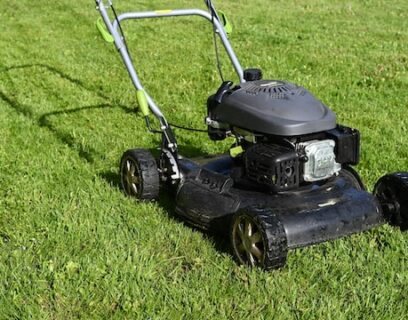

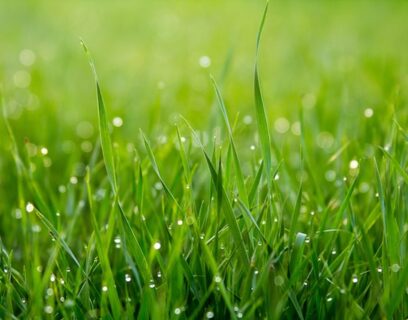






Comments (0)
There are no comments yet. Well then, what are you waiting for to
Be the first to write your comment!inaugurate this pretty page?
Do you have some comments?